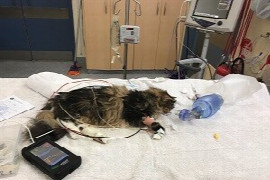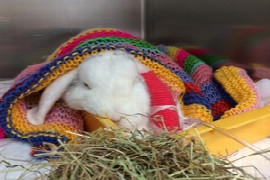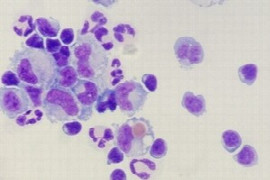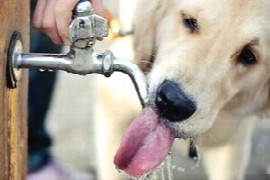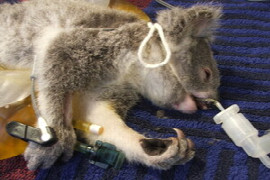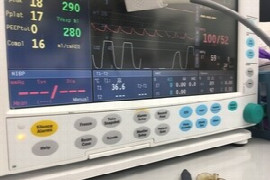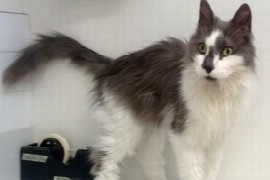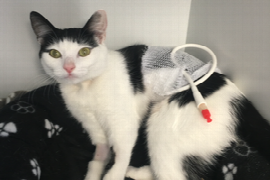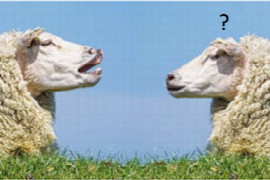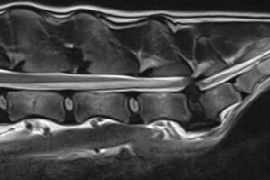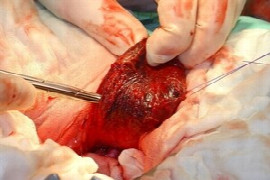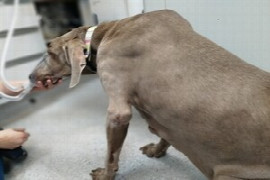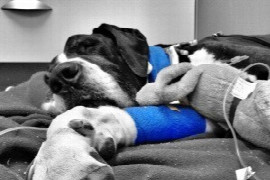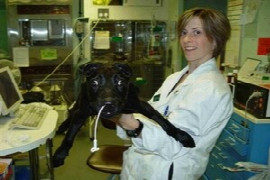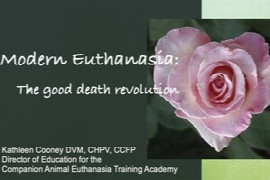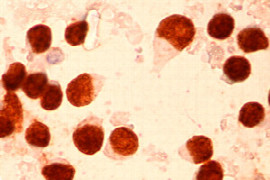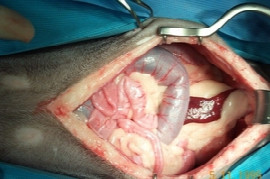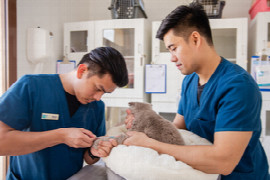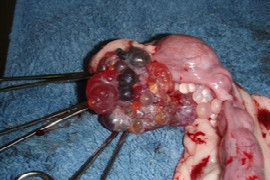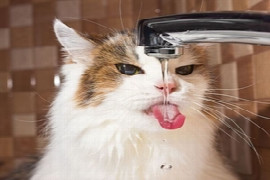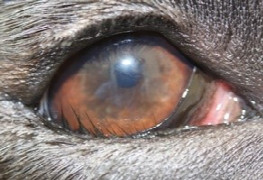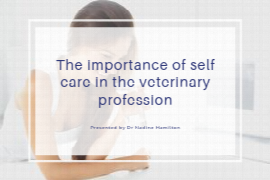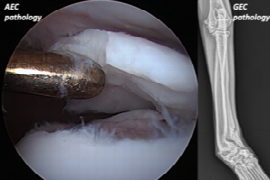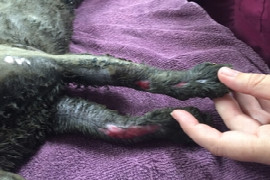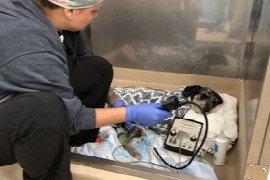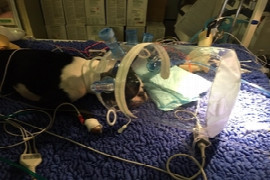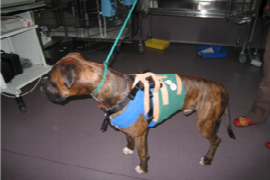Shock – what is it, how is it treated and what do I monitor (for Nurses)
All about Shock A patient presents in “Shock” – what does this actually mean? What is happening to that patient and how can we best treat this critical condition? There are 3 different types of shock - hypovolaemic, distributive and cardiogenic, this webinar will explain what these terms mean and how you can differentiate between the different forms of shock...
Duration:
0:46 h
Speaker:
Skye Carr
from 1
US$ 49.40
(incl. tax)
(incl. tax)
Juggling the Triad of Care at End of Life The Patient The Client and The Care Team
Supporting clients with a pet approaching the end of life can be challenging for everyone. Learning to recognise what your clients need and how to best deliver it as part of a wider inter-disciplinary team, is often critical to the success of a patient care plan.
Duration:
0:47 h
Speaker:
Jackie Campbell
from 1
US$ 49.40
(incl. tax)
(incl. tax)
Emergency Medicine in Rabbits
Emergency and critical care of rabbits is a new concept and an exciting challenge. At presentation, prey species like rabbits may disguise obvious clinical signs making triage more complicated. However most emergency and critical care techniques used in other companion animals can be applied, and familiarity with common rabbit presentations can improve the management of these pets. Ileus, dyspnoea and seizure are examples of possible conditions that, with the right approach, can be treated successfully. Anorexia is also a very common emergency that should be treated within 24-48 hours from presentation. However, anorexia is a clinical sign and not a disease, and the cause should be thoroughly investigated and treated. This webinar will describe the emergency equipment advised for the rabbit patient and some of the most common emergency presentations and their treatments.
Duration:
1:02 h
Speaker:
Livia Benato
from 1
US$ 49.40
(incl. tax)
(incl. tax)
CSF evaluation - Cytology and Infectious Disease Diagnostics (for Nurses)
Evaluation of CSF is an important diagnostic tool for assessment of patients displaying neurological abnormalities. Basic cytological evaluation of CSF includes determination of the total and differential leukocyte counts and protein concentration.
Duration:
0:53 h
Speaker:
Leanne Twomey
from 1
US$ 49.40
(incl. tax)
(incl. tax)
Managing Busy Shifts without Burnout (for Nurses)
Have you been asked to do shift work but feel leery about the rumours of the many challenges that come with it? Or are you a seasoned shift worker feeling like this gruelling schedule is catching up with you as each shift is filled with increasing errors, brain fog, exhaustion, overwhelm - and even weight gain?
Duration:
0:54 h
Speaker:
Dori martin
from 1
US$ 49.40
(incl. tax)
(incl. tax)
Snots and Snuffles: Feline Upper Respiratory Disease
Upper respiratory tract disease is not uncommon in cats, chronic snuffles can be frustrating to manage, and laryngeal disease can be an acute emergency. This webinar will discuss infectious and non-infectious conditions of the upper airway, with practical treatment suggestions and case examples.
Duration:
0:59 h
Speaker:
Samantha Taylor
from 1
US$ 49.40
(incl. tax)
(incl. tax)
Updates in Perioperative Fluid Therapy
Provision of fluid therapy is an important aspect of patient support during anaesthesia. In recent years there have been various guidelines published regarding perioperative fluids in veterinary medicine. However, there are many factors to consider when creating an individualised fluid plan for small animals undergoing anaesthesia. This webinar will guide you through a logical approach to incorporating new information on this topic into your everyday clinical practice. The webinar will cover: indications for the provision of perioperative fluids, choice of fluid type and rate of administration for a range of patients, monitoring changes to fluid requirements during anaesthesia, and potential adverse effects of inappropriate fluid therapy.
Duration:
0:55 h
Speaker:
Jennifer Davis
from 1
US$ 49.40
(incl. tax)
(incl. tax)
Feline Pain Management
Recognising and treating pain can be challenging and particularly so in our feline patients. In this webinar we will look at the importance of recognising and measuring pain and explore the tools available to assess acute pain in cats such as the recently developed grimace scale. We will also review analgesic options and techniques available to treat perioperative pain in our feline patients.
Duration:
0:47 h
Speaker:
Eleanor Holden
from 1
US$ 49.40
(incl. tax)
(incl. tax)
Analgesia and Anaesthesia in Exotic Companion Mammals
As rabbits, guinea pigs, ferrets and rats become increasingly popular pets with close bonds to their owners, these animals are more likely to present to veterinary clinics for routine and urgent care. Collectively known as Exotic Companion Mammals (ECM), the unique anatomy...
Duration:
1:00 h
Speaker:
Jaclyn Gatt
from 1
US$ 49.40
(incl. tax)
(incl. tax)
The clinical approach to paraplegia in dogs
Myelopathies resulting in paraparesis/paraplegia in dogs and cats are commonly encountered in clinical practice. This lecture reviews the clinical and diagnostic approach the dogs presented with paraparesis/paraplegia in describes pathophysiology, clinical presentation, diagnosis, treatment, outcome and prognosis of specific disorders.
Duration:
1:08 h
Speaker:
Elsa Beltran
from 1
US$ 49.40
(incl. tax)
(incl. tax)
Let’s talk cat and dog behaviour at 2nd vac (and put some myths to bed)
The dreaded end of consult question…. “Can I just ask you quickly? Why does my cat spray urine in my kitchen”? Or “How can I stop my dog chewing the sofa when I go out?” These questions, although common place, can often be difficult to answer. But what if we worked towards the owner never having to ask them in the first place?
Fence at the top of the cliff or an ambulance at the bottom?
We can help to prevent common problems from developing by recognising that we are well placed to educate owners during the second vaccination appointment on how to foster emotional resilience in their dog or cat. In other words, if they put the work in at the beginning, then the chance of a behavioural problem developing reduces. Let’s talk about more than worming, nutrition and neutering!
This webinar aims to look at:
• Understanding what motivates cats and dogs and how we reinforce their behaviour – good and bad
• Advising owners on how good intentions early on will lead to good welfare outcomes in a variety of common behavioural challenges
• Recognising the communication and body language that often precedes a dog bite – it’s not about dominance!
Duration:
1:00 h
Speaker:
Hayley Walters
from 1
US$ 49.40
(incl. tax)
(incl. tax)
Is it just an innocent murmur? Congenital Heart Disease in Puppies and Kittens & Cats (for Nurses)
Heart murmurs in young puppies and kittens are often managed incorrectly. We know that a delay in the diagnosis of congenital heart disease can mean incorrect treatments and cause a major impact on longer term prognosis. This webinar will help guide the veterinary team through the assessment, management and prognosis of commonly encountered congenital heart diseases with plenty of practical tips and tricks for improving your knowledge on the subject. It also aims to give delegates confidence when discussing these congenital conditions with owners and colleagues.
Learning Objectives:
• How to identify animals that may have congenital heart disease
• Understand the most appropriate tests and how to perform these well in young animals
• Improve ability to detect and understand the significance of a murmur
• Prognosis and treatment options available for the common congenital heart conditions seen
Duration:
0:57 h
Speaker:
Chris Linney
from 1
US$ 49.40
(incl. tax)
(incl. tax)
Nursing Wildlife - First Aid
Want to know what to do with a fractured wing? Or a possum who came off second best with a cat? What about those car hit koalas which are guaranteed to unsettle even the calmest nurse…..
This seminar will broadly cover first aid principles as they apply to our native wildlife. Building on your domestic animal First aid knowledge and bending it to appropriate measures for wildlife. We will discuss fluid support, analgesia, and triage for incoming wildlife, as well as broad guidelines for decision making when it comes to euthanasia, in clinic treatment, or referral on to wildlife specialist practices. Lead by Dr Robyn Stenner, with over 10 years’ experience as a wildlife veterinarian, this seminar will be packed full of simple yet effective and time saving points to help you and the clinic more confidently care for wildlife.
Duration:
1:04 h
Speaker:
Robyn Stenner
from 1
US$ 49.40
(incl. tax)
(incl. tax)
Feline Nutrition, A Clinicians Perspective
What should we feed cats? Raw meaty bones vs commercial “complete and balanced” diets? Commercial cat food has resulted in decreased in hypervitaminosis A, thiamine deficiency and secondary nutritional hyperparathyroidism. But should this be used as evidence that alternative diets based on ancestral diets should not be used when none of these cited conditions would occur with an ancestral diet? In addition, it is easy to assess improvement in known straightforward dietary-related conditions but far more difficult to detect increased or decreased incidence of medical diseases where the contribution of diet is more subtle. Any improvement in medical diseases due to commercial diets needs to be balanced against the emergence of potential adverse conditions but this data is rarely present. We hear from nutritionists but not clinicians. This unique lecture is given from a feline medicine specialist’s perspective.
Duration:
1:05 h
Speaker:
Sue Foster
from 1
US$ 49.40
(incl. tax)
(incl. tax)
Principles of Ventilation for Nurses
This webinar will cover the following topics:
• Which patients to ventilate, how to start ventilation and wean from the ventilator
• Basic settings for ventilators
• How to troubleshoot common problems
Duration:
0:37 h
Speaker:
Karla Borland
from 1
US$ 49.40
(incl. tax)
(incl. tax)
Nursing the Vestibular Patient
Can you imagine waking up one day feeling like the world is unexpectedly spinning out of control and suddenly you can’t stand up straight let alone walk a few steps? You feel nauseous, unbalanced and scared. This is how our vestibular disease patients find...
Duration:
0:38 h
Speaker:
Skye Carr
from 1
US$ 49.40
(incl. tax)
(incl. tax)
Advanced Mechanical Ventilation
This webinar will try and cover the current employed strategies and predictors for an optimised outcome of the mechanically ventilated patients based on the current evidence from human and veterinary medicine.
Duration:
1:06 h
Speaker:
Manuela Pascal
from 1
US$ 49.40
(incl. tax)
(incl. tax)
Basics of Obstetrics
Requests for veterinary obstetrical assistance are becoming more common for clinicians in private practice and cases of dystocia are frequently encountered in emergency clinical settings. The emotional and financial value of stud dogs, breeding bitches and their offspring makes the preventable loss of even one neonate undesirable. It is therefore important for veterinarians to understand the whelping process and the basics of obstetrics.
Duration:
1:05 h
Speaker:
Nadine Apteker
from 1
US$ 49.40
(incl. tax)
(incl. tax)
The Hyperthyroid Cat
Originally recognised approximately 40 years ago, hyperthyroidism is the most common feline endocrinopathy. How has our understanding of this common disease of cats and it’s management changed since then? This webinar will revisit the diagnostic approach, management options, complications and currently recommended monitoring for these patients. Which medical treatment option is best and why? How often does iatrogenic hypothyroidism occur and how can we diagnose and treat this in cats? What are the renal implications of thyroid disease in cats and how can we best assess and monitor this in these patients? Update and refresh your knowledge of this common feline disease.
Duration:
0:59 h
Speaker:
Lara Boland
from 1
US$ 49.40
(incl. tax)
(incl. tax)
Nursing the Hepatic Lipidosis Patient
Hepatic lipidosis is a common cause of acquired liver disease in cats. It is a multifactorial syndrome and factors such as anorexia, stress and concurrent disease are associated with the development of the condition. The veterinary nurse is heavily involved in managing the hepatic lipidosis patient, from assistance with diagnostic imaging and investigations, to administering prescribed treatment, implementing a nutritional plan and day-to-day monitoring and nursing care. This webinar will discuss the pathophysiology, diagnosis and treatment of hepatic lipidosis, as well as the vital role of the veterinary nurse in caring for these patients.
Duration:
1:00 h
Speaker:
Laura Rosewell
from 1
US$ 49.40
(incl. tax)
(incl. tax)
Say what?! Common mistakes German speakers make - from a veterinary medical perspective
We will cover common mistakes typically made by German speakers and how to correct them. We will relate how these common mistakes affect communication with colleagues and animal owners and impact upon being properly understood.
Duration:
0:41 h
Speaker:
Cindy L. Willheim
from 1
US$ 49.40
(incl. tax)
(incl. tax)
Lumbosacral Stenosis
This vet-webinar reviews the aetiology, diagnosis and management of degenerative lumbosacral stenosis. Lumbosacral stenosis occurs when soft tissue and/or bony changes impinge on the nerve roots or vasculature of the cauda equina. The impingement can be worsened in conjunction with abnormal motion of the lumbosacral joint. Lumbosacral stenosis occurs most frequently in middle-aged dogs of medium to large breed, and German Shepherd dogs are predisposed to this disease. Common signs are lumbosacral pain, lameness, pelvic limb weakness and ataxia, and urinary incontinence. Diagnosis is based on clinical features and imaging studies. Depending on the severity of the compression but about 50% of dogs respond well to conservative treatments. Decompressive surgery is effective in most patients.
Duration:
0:55 h
Speaker:
Dorothee Krainer
from 1
US$ 49.40
(incl. tax)
(incl. tax)
Surgery of the Urinary System: When, how and why to use cystotomy tubes.
In this webinar we will be discussing how to manage cases that require urinary diversion. This may be a blocked cat, urethral trauma, neurological disease, or palliative care for trigonal neoplasia. Understanding how to best manage these patients in the short and long term is essential to the overall success of treatment. Although urethral catheterisation is relatively simple, it can be challenging in some cases and it never allows us to assess the patient’s ability to urinate when it is still in place. In contrast, a cystotomy tube is predictable to place and allows long term management, including being able to assess voluntary urination without removal. We will discuss when, how and why to use cystotomy tubes so that this technique can be applied in a wide range of scenarios in general practice.
Duration:
0:49 h
Speaker:
Kat Crosse
from 1
US$ 49.40
(incl. tax)
(incl. tax)
Oxygen Therapy (for Nurses)
There are many conditions where a patient may require supplemented oxygen, for example, dyspnoea, shock, sepsis, SIRs and head trauma. This webinar will address the difference between hypoxaemia and hypoxia, as well as the methods of oxygen delivery available to each patients needs and the fraction of inspired oxygen each provides. Humidification of oxygen, oxygen toxicity and other complications of oxygen therapy will be reviewed. Finally there will be a comprehensive look at how to monitor successful oxygen therapy and the techniques/ equations used to assess the oxygenation and ventilation of the patient.
Duration:
0:40 h
Speaker:
Chloe Fay
from 1
US$ 49.40
(incl. tax)
(incl. tax)
The behavioural effects in pets with owners being asked to socially distance
“The pandemic has changed things for everyone. It has made everyone think about how we interact with pets, not only now but also in the new normal, whatever that may be. Veterinarians and veterinary staff deal with pets daily and recognise the signs of fear, anxiety and stress but when do these signs mean that that things are serious and what advice should you give? How can you make things better for everyone?”
Duration:
0:54 h
Speaker:
Kersti Seksel
from 1
US$ 49.40
(incl. tax)
(incl. tax)
Central Venous Pressure in the Veterinary Patient (for Nurses)
Central venous pressure (or CVP) monitoring has been used in veterinary medicine as a tool for monitoring cardiac function and managing fluid therapy. In critical patients and complex anaesthetics, the technique expands the availability of information we have for patient management and helps provide a more complete picture of how the cardiovascular system is operating in conjunction with other monitoring techniques. As veterinary nurses/technicians, is it important to understand when, how and why to use central lines for critical patients and the importance of central line care and maintenance post-operatively.
This webinar will discuss the use of CVP monitoring in small animal practice with an overview of placement and management of central lines, techniques for monitoring CVP, interpretation of CVP and its limitations. We will also cover some of the controversies with its use in human medicine and briefly touch on other uses for central lines in our critical patients. Being comfortable with CVP monitoring will provide benefits in monitoring those complicated anaesthetics in critical patients and confidence in helping to make correct management decisions for better patient outcomes.
Duration:
0:36 h
Speaker:
Cheryl MacPherson
from 1
US$ 49.40
(incl. tax)
(incl. tax)
We are all ears! Management strategies for otitis externa
Otitis externa is a commonly encountered condition in general practice and referral practice. Identifying the predisposing, primary and perpetuating factors associated with otitis externa is a key component in gaining control of this condition long term. This webinar will cover the...
Duration:
0:47 h
Speaker:
Danielle Hoolahan
from 1
US$ 49.40
(incl. tax)
(incl. tax)
Tetanus – treatment for the board stiff!
Tetanus is an uncommon condition in dogs (and an under- recognised one in cats) that poses an almost unique set of therapeutic challenges. Wound contamination with the eponymous Clostridia bacteria results in neurotoxicity causing spastic muscular paralysis, and can be frequently fatal in companion animals. Most of these patients require lots of nursing care, physiotherapy and interventional nutrition, as well as medical and surgical treatment for the causative infection.
This webinar will help you through some of the challenges in diagnosis and definitive treatment, as well as providing guidelines for the successful supportive care of these difficult patients. Tetanus can be a very curable disease, with the right support at the right time, and is often manageable in practice.
Duration:
1:14 h
Speaker:
Daniel Lewis
from 1
US$ 49.40
(incl. tax)
(incl. tax)
Pre-anaesthetic assessment of the small animal patient (for Nurses)
Anaesthesia is a vital tool in small animal practice to facilitate diagnostic, corrective and curative procedures. Principles of appropriate drug choices and techniques are paramount to reduce peri-anaesthetic complications. But how do we come to make these choices? Pre-anaesthetic assessment of the individual patient in respect to signalment, disease status and procedure is invaluable in making these decisions. Pertinent history, and thorough physical examinations are the cornerstone to guide further relevant testing. Risk assessments and the factors that influence these risks, need to be identified and remedied where possible, prior to anaesthesia. Diagnostic testing with respect to blood work, electrocardiograms, and imaging are point of care tools which can add significant information to assist in our quest for the most appropriate peri-anaesthetic plan.
Duration:
0:57 h
Speaker:
Louise Bass
from 1
US$ 49.40
(incl. tax)
(incl. tax)
Modern Euthanasia: The good death revolution (for Nurses)
Euthanasia is going through an evolution. It is changing for the better; techniques, protocols, pricing, and attitudes. Patients deserve the best, clients demand the best, and our veterinary teams want to deliver it. We will explore new trends in hospital euthanasia experiences, reinforce those oldie but goodie protocols, and even dive into the new concept of dysthanasia. Led by Dr. Kathleen Cooney, founder and director of education for the Companion Animal Euthanasia Training Academy, this webinar will become the spark to modernize your euthanasia appointments.
Duration:
0:49 h
Speaker:
Kathleen Cooney
from 1
US$ 49.40
(incl. tax)
(incl. tax)
Advanced diagnostics in canine and feline lymphoma.
So you have a diagnosis of lymphoma in your small animal patient. What next? Classification of lymphoma is increasingly important for both prognostic and therapeutic decision making. This webinar will discuss diagnostic options to optimise the diagnostic process in your patient. Modalities discussed will include immunocytochemistry, immunohistochemistry, flow cytometry and PARR.
Duration:
0:50 h
Speaker:
Sue Jaensch
from 1
US$ 49.40
(incl. tax)
(incl. tax)
Resilience and Wellbeing Practices for Veterinary Nurses
The experience of stress is a personal one, and no two people will experience situations the same way. An event at work that could be considered a major stressful event for one nurse, may be seen by others as energising and challenging.
This webinar will explore evidence-based practices for developing resilience, and subsequently, greater wellbeing as a veterinary nurse. Topics include:
• Developing emotional insight, and self-awareness skills
• Personal resilience-building and wellbeing practices
• Practical strategies for handling difficult situations at work
Duration:
0:59 h
Speaker:
Rosie Overfield
from 1
US$ 49.40
(incl. tax)
(incl. tax)
Avoid the “Peak and Shriek” - Getting the most out of your exploratory laparotomies.
In this lecture, Charles will be presenting a systematic approach to the abdominal exploration in dogs and cats, concentrating on indications, what to look for when you’re in the abdomen and what to do when you find abnormalities. He will also discuss biopsy techniques and some tricks for intestinal resection and anastomosis.
Duration:
0:41 h
Speaker:
Charles Kuntz
from 1
US$ 49.40
(incl. tax)
(incl. tax)
Workplace Wellbeing and Managing Shift-Work
Numerous research has shown shift workers are prone to various chronic health complaints including gastrointestinal complaints, obesity, insulin resistance, cardiovascular disease, mental health disorders, depleted immune systems – to name a few. This stems largely from ongoing sleep deprivation and disruption to the sleep/wake cycle, along with subsequent misalignment of biological circadian rhythms which often induces fatigue, leading to poor dietary and lifestyle habits.
In this webinar, Audra Starkey will explore:
- Why sleep prioritization is critical for anyone working 24/7
- Strategies to support the parasympathetic nervous system to encourage better sleep
- The influence of chrononutrition in the management of shift work wellness
- Shift work nutrition – eating to support more energy, better digestive health and weight regulation
Duration:
0:59 h
Speaker:
Audra Starkey
from 1
US$ 49.40
(incl. tax)
(incl. tax)
Tips for Creating a Cat Friendly Environment in the Veterinary Emergency Room and Critical Care Setting
We as veterinarians are becoming more and more aware of the impact that a veterinary visit can have on the mental and emotional health of our patients. Cats seem to be particularly affected by leaving their known environments and entering into a new environment that can hold a multitude of unknown and unpleasant stressors. Imagine how heightened the perception of these stressors may be in an emergency or critical care setting. In this webinar, we will look at why it is so important to manage feline stress in the above mentioned settings and discuss easy to implement and practical strategies for the hospital, emergency room and critical care environment in order to improve recovery and outcome as well as create a safer and more pleasurable workplace for the veterinary team.
Duration:
0:56 h
Speaker:
Katrin Jahn
from 1
US$ 49.40
(incl. tax)
(incl. tax)
CSF evaluation - Cytology and Infectious Disease Diagnostics
Evaluation of CSF is an important diagnostic tool for assessment of patients displaying neurological abnormalities. Basic cytological evaluation of CSF includes determination of the total and differential leukocyte counts and protein concentration. In addition, other cytological abnormalities including atypical or neoplastic cells, infectious agents or evidence of haemorrhage may be identified. Pre-analytic variables, clinical signs and species variations must be taken into consideration when interpreting cytological findings. Characterising the type of inflammatory response can help to clarify the underlying pathological processes. Identification of infectious agents can be achieved using a number of methodologies and is a vital component of accurate diagnosis and treatment of neurological disease.
Duration:
0:47 h
Speaker:
Leanne Twomey
from 1
US$ 49.40
(incl. tax)
(incl. tax)
Pyometra in Small Animals
With increasing population of dogs being entire for longer, and the desire to treat medically rather than surgically performing an ovariohysterectomy, pyometra in small animal practice is becoming a commonly encountered problem. Here we review the medical and surgical options available for this disease.
Duration:
1:02 h
Speaker:
Xavier Schneider
from 1
US$ 49.40
(incl. tax)
(incl. tax)
FLUTD – Is it all about nutrition - for Nurses
Urinary tract disorders in cats is a truly multifactorial issue. Good history taking, including nutritional and behavioural, is required in order to give the best recommendations for the cat. Nutrition plays an important element of this, but it isn’t just about what the cat eats, but how the food is presented and feeding behaviours that impact on the cat.
The webinar will look at nutrients in the diet and how these impact on cats with FLUTD, but also feeding behaviour. We will look at how we feed cats plays a much larger role in FLUTD, in how it influences stress levels and potential interactions with other cats in the household.
We will also look at how obesity and weight loss diets effects cats with FLUTD.
Duration:
0:58 h
Speaker:
Nicola Lakeman
from 1
US$ 49.40
(incl. tax)
(incl. tax)
Issues with eyelids
Diseases affecting the eyelids are frequently encountered in small animal practice, affecting both dogs and cats. We will briefly consider the anatomy and function of the eyelids before looking in more detail at medical and surgical conditions. With the former it is important to remember that eyelid disease can sometimes be part of a generalised condition – such as atopy, or can be secondary to another eye disease – blepharitis as an extension from a bacterial conjunctivitis for example. Conditions such as entropion and ectropion might require surgical correction and we will see examples of these with tips for how to achieve the best outcome for the patient – the aim is always to restore normal function with minimal scarring. A correct diagnosis and meticulous attention to detail is required to attain this. Other common conditions such as eyelid tumours and distichiasis will be mentioned, and we will finish up with a few complications - and how to avoid them!
Duration:
1:05 h
Speaker:
Sally Turner
from 1
US$ 49.40
(incl. tax)
(incl. tax)
The importance of self-care in the veterinary profession (for Nurses)
The veterinary profession has a high rate of burnout and suicide, to which many factors contribute. This webinar will look at what research has shown to be the top five factors affecting veterinary professionals, and what can be done about it. It will also address the importance of good nutrition, exercise, sleep hygiene, as well as why self-care should be a priority to try and combat the often negative side-effects of working within the veterinary industry.
Duration:
1:02 h
Speaker:
Nadine Hamilton
from 1
US$ 49.40
(incl. tax)
(incl. tax)
Canine Epiphyseal Disease
The epiphysis is located at either end of long bones and is evident within the fetus approximately four weeks post conception. During growth, the epiphysis is comprised of specialized cartilage, including articular epiphyseal cartilage (AEC) and growth plate epiphyseal cartilage (GEC), together accounting for longitudinal growth of long bones. In maturity, most of the epiphyseal cartilage is replaced with trabecular bone, encased in a thin shell of cortical bone with hyaline cartilage persisting at the joint surface.
Epiphyseal pathology sustained during growth can have profound lifelong consequence. This webinar reviews common epiphyseal pathologies, including articular and growth plate osteochondrosis and epiphyseal trauma. A focus on diagnosis, treatment and expected outcomes with practical tips and tricks for use in your practice is presented.
Duration:
1:05 h
Speaker:
Ricky Cashmore
from 1
US$ 49.40
(incl. tax)
(incl. tax)
Fire Related Injuries (for Nurses)
In this webinar we will discuss the care of fire related injuries. A short overview of skin layers and degree of burn injuries will be discussed. We will cover triage and first aid of fire victims, respiratory emergencies such as smoke inhalation and carbon monoxide poisoning, wound management both acute and ongoing. The importance of nutrition and analgesia as well as shock and fluid therapy in these cases will also be discussed.
Duration:
1:10 h
Speaker:
Kate Tinney
from 1
US$ 49.40
(incl. tax)
(incl. tax)
Blood Pressure Monitoring for Veterinary Technicians and Nurses
A patient's blood pressure gives the nursing team valuable information about patient perfusion, fluid balance, and disease status. Are you confident understanding what blood pressure readings mean? Are you comfortable both setting up and interpreting direct arterial blood pressure monitoring? How can you troubleshoot and treat both hyper and hypotension? Are you aware of the disease processes that can change blood pressure? The webinar will answer all of those questions and more!
Duration:
0:51 h
Speaker:
Megan Brashear
from 1
US$ 49.40
(incl. tax)
(incl. tax)
Dealing with Imposter Syndrome
If you are completely honest with yourself, do you believe your failings are all your own fault, but your successes are pure good luck or a fluke? Are you forever wondering when the ‘fraud police’ are going to come and expose you for being a phony? Would you believe you aren’t alone? If you have ever felt like you didn’t belong somewhere or that your colleagues, friends, and associates are going to discover you are a phony and fraud and that you really don’t deserve the success, then you are not alone. These feelings are referred to as ‘imposter phenomenon’ or ‘imposter syndrome’ and it is estimated that at some point in life, around 70% of people will experience these feelings. Imposter syndrome affects a wide range of people from all aspects of life and this webinar will take a deeper look into the causes, symptoms, and ways you can deal with it.
Duration:
0:53 h
Speaker:
Nadine Hamilton
from 1
US$ 49.40
(incl. tax)
(incl. tax)
Mechanical Ventilation: The Basics
Mechanical ventilation is becoming a common therapeutic tool in veterinary medicine. Mechanical ventilation is often necessary in cases of hypoxic or hypercapnic respiratory failure, shock, coma, or cardiac arrest. In this seminar, we will discuss the mechanics of ventilation, the different ventilatory modes (pressure and volume controlled), their strengths, limitations, similarities and differences, we will also discuss their indications, and we will learn how to set up and adjust the setting for our patients. This seminar is centred around the concept of lung-protection and the open-lung theory.
Finally, we will use a couple of ventilator models as example for the configuration setting up.
This is a dynamic seminar with great and practical videos that will help you understand what is happening in the lungs when we program certain parameters in the ventilator. Finally, we will discuss about the patient weaning from the ventilator and the best strategies to achieve a positive outcome in these patients.
Duration:
1:01 h
Speaker:
Fernando Martinez-Taboada
from 1
US$ 49.40
(incl. tax)
(incl. tax)
An Update on Socialisation: What you need your clients to know
Socialisation has become all-important to ensure that a puppy grows up to be a healthy adult dog. If it is not done right, then the dog is ruined! But is this really true? A lack of socialization is blamed for all types of behaviour problems of dogs - but is this really accurate?
Socialisation is important for the healthy development of all youngsters, not just dogs. Even humans get socialized! It is more than just exposing the young animal to new experiences. The emphasis of exposure to novelty has overshadowed the importance of the caregiver to successful socialization. We will explore what it means to socialize a dog, what puppy breeders, puppy walkers and puppy owners need to be doing to help their puppy adapt to life with people (it is much easier than we think!). How the puppy adapts to learning about the wider world can help identify developmental problems and mental health disorders allowing early interventions. A well socialized animal makes the job of the veterinarians and veterinary staff easier as the animal is comfortable with meeting new people and learning new things. So advising your clients correctly helps them help their puppy which ultimately helps you do your job better!
Duration:
0:43 h
Speaker:
Jacqui Ley
from 1
US$ 49.40
(incl. tax)
(incl. tax)
Canine Dilated Cardiomyopathy
This webinar will discuss the pathophysiology of canine DCM and the common causes, diagnosis and treatment of dilated cardiomyopathy (DCM) in dogs. Nutritional DCM will be discussed as will differentiating degenerative mitral valve disease from DCM in large breed dogs.
Duration:
1:01 h
Speaker:
Richard Woolley
from 1
US$ 49.40
(incl. tax)
(incl. tax)
Special Needs of Geriatric Patients (for Nurses)
In recent years, small animal veterinary medicine has known major improvements in knowledge and quality of care, following the progress of human medicine. Our pet population is aging, revealing some conditions previously poorly recognised. Thus veterinary professionals are faced with new challenges. We need to study how our pets are aging, which structures are affected, and what physiological and pathological mechanisms are at play. Interestingly, dogs and cats, because they live alongside their owner, share the same environment, but have a shorter lifespan, can be good models for some human conditions such as Alzheimer’s disease, obesity and osteoarthritis.
Pet owners are keen to look after their pets for as long as possible, with a major emphasis on maintaining a good quality of life and avoiding pain. We will discuss how we can be with them every step of the way, to provide support and guidance, in all aspects of old age management: pain management, preventative treatments, environmental adaptations, nutritional support and so on. Because looking after our aging pets can give us an insight into how we, as humans, age. So that we all age well, together.
Duration:
0:49 h
Speaker:
Mathilde Granger
from 1
US$ 49.40
(incl. tax)
(incl. tax)
